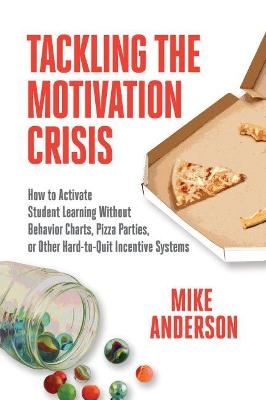
Tackling the Motivation Crisis
How to Activate Student Learning Without Behavior Charts, Pizza Parties, or Other Hard-to-Quit Incentive Systems
Seiten
2021
Association for Supervision & Curriculum Development (Verlag)
978-1-4166-3033-3 (ISBN)
Association for Supervision & Curriculum Development (Verlag)
978-1-4166-3033-3 (ISBN)
Our job as teachers is not to motivate our students. It's to make sure that our classrooms and schools are places that inspire their intrinsic motivation and allow it to flourish. This book shows how you can better do that right away - no matter what grade level or subject area you teach.
Packed with practical strategies you can use to create a culture of self-motivation in your school!Teachers use traditional incentive and reward systems with the best of intentions. We're trying to support students' positive behavior and learning. We're hoping to motivate and inspire students to work hard and do well in school. If everyone behaves, we'll have a pizza party. The more books you read, the more stickers you'll receive. On the surface, these systems seem to make sense. They may even seem to work. But in the long term, they do not foster intrinsic motivation or a love of learning. In fact, they often have the opposite effect.
In Tackling the Motivation Crisis: How to Activate Student Learning Without Behavior Charts, Pizza Parties, or Other Hard-to-Quit Incentive Systems, award-winning educator and best-selling author Mike Anderson explains
* The damage done by extrinsic motivation systems and why they are so hard for us to give up.
* What intrinsic motivation looks like and the six high-impact motivators—autonomy, belonging, competence, purpose, fun, and curiosity—that foster it.
* How to teach the self-management and self-motivation skills that can make a difference for kids.
* How to use intrinsic motivation in curricula and instructional strategies, feedback and assessment, and discipline and classroom management.
Ultimately, our job as teachers is not to motivate our students. It's to make sure that our classrooms and schools are places that inspire their intrinsic motivation and allow it to flourish. Anderson shows how you can better do that right away—no matter what grade level or subject area you teach.
Packed with practical strategies you can use to create a culture of self-motivation in your school!Teachers use traditional incentive and reward systems with the best of intentions. We're trying to support students' positive behavior and learning. We're hoping to motivate and inspire students to work hard and do well in school. If everyone behaves, we'll have a pizza party. The more books you read, the more stickers you'll receive. On the surface, these systems seem to make sense. They may even seem to work. But in the long term, they do not foster intrinsic motivation or a love of learning. In fact, they often have the opposite effect.
In Tackling the Motivation Crisis: How to Activate Student Learning Without Behavior Charts, Pizza Parties, or Other Hard-to-Quit Incentive Systems, award-winning educator and best-selling author Mike Anderson explains
* The damage done by extrinsic motivation systems and why they are so hard for us to give up.
* What intrinsic motivation looks like and the six high-impact motivators—autonomy, belonging, competence, purpose, fun, and curiosity—that foster it.
* How to teach the self-management and self-motivation skills that can make a difference for kids.
* How to use intrinsic motivation in curricula and instructional strategies, feedback and assessment, and discipline and classroom management.
Ultimately, our job as teachers is not to motivate our students. It's to make sure that our classrooms and schools are places that inspire their intrinsic motivation and allow it to flourish. Anderson shows how you can better do that right away—no matter what grade level or subject area you teach.
Mike Anderson has been an educator for more than 25 years. In 2004, Anderson was awarded a national Milken Educator Award, and in 2005, he was a finalist for New Hampshire Teacher of the Year. Now an education consultant, Anderson works with schools in rural, urban, and suburban settings across the United States and beyond. Anderson is the author of many books about great teaching and learning including The Well-Balanced Teacher, Learning to Choose, Choosing to Learn, and the best-selling What We Say and How We Say It Matter. He lives in Durham, New Hampshire, with his amazing family: Heather, Ethan, and Carly.
| Erscheinungsdatum | 01.09.2021 |
|---|---|
| Sprache | englisch |
| Maße | 152 x 229 mm |
| Gewicht | 333 g |
| Themenwelt | Geisteswissenschaften ► Psychologie ► Pädagogische Psychologie |
| Sozialwissenschaften ► Pädagogik | |
| ISBN-10 | 1-4166-3033-3 / 1416630333 |
| ISBN-13 | 978-1-4166-3033-3 / 9781416630333 |
| Zustand | Neuware |
| Haben Sie eine Frage zum Produkt? |
Mehr entdecken
aus dem Bereich
aus dem Bereich
Grundlagen, Diagnostik und Förderung
Buch | Softcover (2023)
Kohlhammer (Verlag)
29,00 €
beliebte Übungen für die Arbeit mit Gruppen
Buch (2023)
Borgmann Media (Verlag)
21,95 €
Buch | Softcover (2024)
Springer (Verlag)
24,99 €


